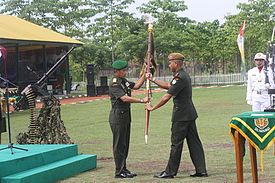
A salute is usually a formal hand gesture or other action used to display respect in military situations. Salutes are primarily associated with the military and law enforcement, but many civilian organizations, such as Girl Guides, Boy Scouts and the Salvation Army use formal salutes. Ordinary civilians also salute informally to greet or acknowledge the presence of another person, such as a tip of the hat or a hand wave to a friend or neighbour.

In military organizations, a colour guard is a detachment of soldiers assigned to the protection of regimental colours and the national flag. This duty is highly prestigious, and the military colour is generally carried by a young officer (ensign), while experienced non-commissioned officers are assigned to the protection of the national flag. These non-commissioned officers, accompanied in several countries by warrant officers, can be ceremonially armed with either sabres or rifles to protect the colour. Colour guards are generally dismounted, but there are also mounted colour guard formations as well.

The Tomb of the Unknown Soldier is a historic funerary monument dedicated to deceased U.S. service members whose remains have not been identified. It is located in Arlington National Cemetery in Virginia, United States. The World War I "Unknown" is a recipient of the Medal of Honor, the Victoria Cross, and several other foreign nations' highest service awards. The U.S. Unknowns who were interred are also recipients of the Medal of Honor, presented by U.S. presidents who presided over their funerals. The monument has no officially designated name.
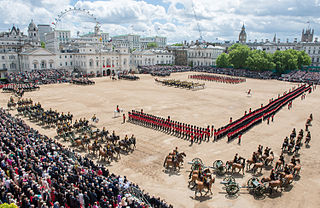
Trooping the Colour is a ceremonial event performed every year on Horse Guards Parade in London, United Kingdom, by regiments of Household Division, to celebrate the official birthday of the British sovereign. It is also known as the Sovereign's Birthday Parade. Similar events are held in other countries of the Commonwealth. In the UK, it is, with the State Opening of Parliament, one of the biggest events of the ceremonial calendar, and watched by millions on TV and on the streets of London.

Drill commands are generally used with a group that is marching, most often in military foot drills or in a marching band. Drill commands are usually heard in major events involving service personnel, reservists and veterans of a country's armed forces, and by extension, public security services and youth uniformed organizations.

A drill instructor is a non-commissioned officer in the armed forces, fire department, or police forces with specific duties that vary by country. Foot drill, military step, and marching are typically taught by drill instructors.

Guard mounting, changing the guard, or the changing of the guard, is a formal ceremony in which sentries performing ceremonial guard duties at important institutions are relieved by a new batch of sentries. The ceremonies are often elaborate and precisely choreographed. They originated with peacetime and battlefield military drills introduced to enhance unit cohesion and effectiveness in the late 17th and early 18th centuries.
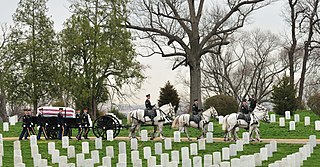
A military funeral is a memorial or burial rite given by a country's military for a soldier, sailor, marine or airman who died in battle, a veteran, or other prominent military figures or heads of state. A military funeral may feature guards of honor, the firing of volley shots as a salute, drumming and other military elements, with a flag draping over the coffin.

The 3rd United States Infantry Regiment is a regiment of the United States Army. It currently has three active battalions, and is readily identified by its nickname, The Old Guard, as well as Escort to the President. The regimental motto is Noli Me Tangere. The regiment is a major unit of the Military District of Washington (MDW).
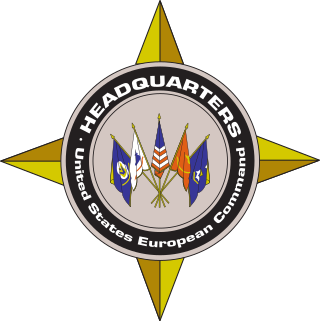
The United States European Command (EUCOM) is one of the eleven unified combatant commands of the United States military, headquartered in Stuttgart, Germany. Its area of focus covers 21,000,000 square miles (54,000,000 km2) and 51 countries and territories, including Europe, The Caucasus, Russia and Greenland. The Commander of the United States EUCOM simultaneously serves as the Supreme Allied Commander, Europe (SACEUR) within NATO, a military alliance. During the Gulf War and Operation Northern Watch, EUCOM controlled the forces flying from Incirlik Air Base.

The United States Army Military District of Washington (MDW) is one of nineteen major commands of the United States Army. Its headquarters are located at Fort Lesley J. McNair in Washington, D.C. The missions of the units in the Military District of Washington include ceremonial tasks as well as a combat role in the defense of the National Capital Region.

The United States Air Force Honor Guard is the official ceremonial unit of the United States Air Force and is assigned to Joint Base Anacostia-Bolling, Washington D.C.

The three-volley salute is a ceremonial act performed at military funerals and sometimes also police funerals. The custom originates from European dynastic wars, in which the fighting ceased so that the dead and wounded could be removed. After this was accomplished, three shots were fired into the air to signal that the battle could resume.
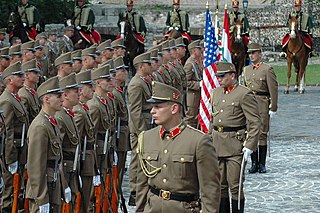
A guard of honour (GB), also honor guard (US), also ceremonial guard, is a group of people, usually military in nature, appointed to receive or guard a head of state or other dignitaries, the fallen in war, or to attend at state ceremonials, especially funerals. In military weddings, especially those of commissioned officers, a guard, composed usually of service members of the same branch, form the sabre arch. In principle, any military unit could act as a guard of honour. However, in some countries certain units are specially designated to serve as a guard of honour, as well as other public duties. Republican Guards, Royal Guards and foot guards frequently have ceremonial duties assigned to them.

The United States Army Old Guard Fife and Drum Corps is one of four premier musical organizations of the United States Army. Members perform using musical instruments and wearing uniforms similar to those used by military musicians of the Continental Army during the American Revolution.
The Thai Royal Guards parade, also known as Trooping the Colour, occurs every December 2 since 1953, in celebration of the birthday of the King of Thailand, during which the King's Guard of the Royal Thai Armed Forces perform a military parade and pledge loyalty to the monarch. The venue is the Royal Plaza at Bangkok, Thailand, in front of the Dusit Palace and its Ananta Samakhom Throne Hall.

A military funeral in the United States is a memorial or burial rite conducted by the United States Armed Forces for a Soldier, Marine, Sailor, Airman, Guardian or Coast Guardsman who died in battle, a veteran, or other prominent military figures or a president. A military funeral may feature guards of honor, the firing of volley shots as a salute, drumming and other military elements, with a flag draping over the coffin.

The Beijing Garrison Honor Guard Battalion, officially the PLA Honour Guard, is a ceremonial honour guard and specialised unit of the People's Liberation Army (PLA). It is composed of representatives of the People's Liberation Army Ground Force, Navy, and Air Force. Male soldiers in the battalion must be at least 160 cm tall, while females must be at least 153 cm tall. This honor guard battalion, while reporting directly to the Central Military Commission, falls under the operational control of the Central Theater Command. During parades, the battalion is led by a color guard detail bearing the PLA flag, a tradition which began in 1981.

The Ceremonial Unit of the Cuban Revolutionary Armed Forces is a ceremonial rituals battalion of the Cuban Revolutionary Armed Forces. Since its foundation on December 15, 1961, the male and female members of the unit has provided honours for the Communist Party of Cuba, the Government of Cuba, and the Revolutionary Armed Forces (FAR). The unit uses intense physical and political techniques, including martial, maintain the discipline that is required for the soldiers and officers of the ceremonial unit.

The Presentation of Colours is a military ceremony that marks an anniversary or significant event in the history of a particular regiment or similar military unit. This involves the presentation of a new version of the regimental colour to a regiment or equivalent formation in their respective armed forces service branch. This is a traditional ceremony that was pioneered by the British Armed Forces, and is today used in most Commonwealth countries.

